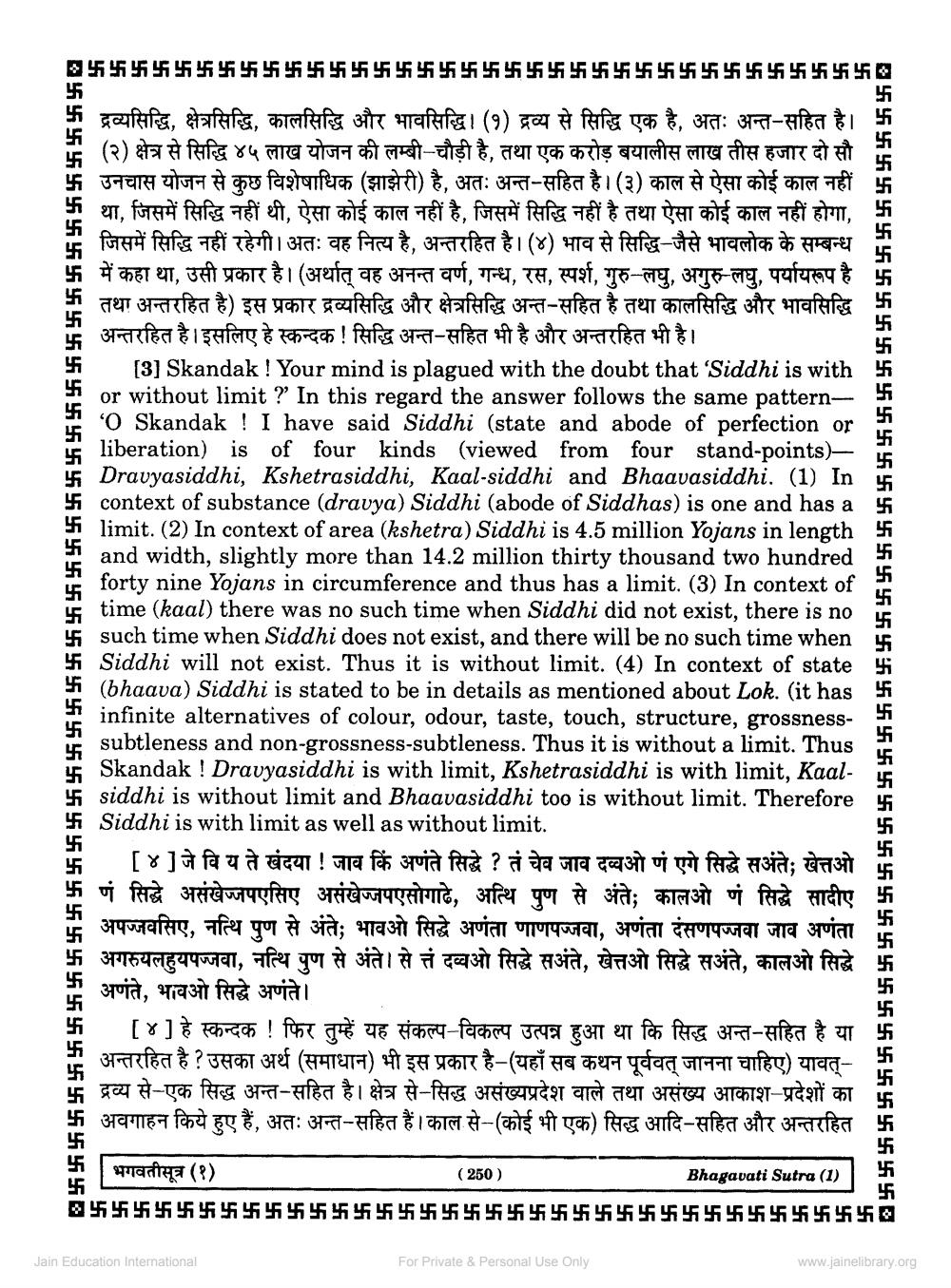________________
))))59555555
))))))))
द्रव्यसिद्धि, क्षेत्रसिद्धि, कालसिद्धि और भावसिद्धि। (१) द्रव्य से सिद्धि एक है, अतः अन्त-सहित है। 5
(२) क्षेत्र से सिद्धि ४५ लाख योजन की लम्बी-चौड़ी है, तथा एक करोड़ बयालीस लाख तीस हजार दो सौ ॐ उनचास योजन से कुछ विशेषाधिक (झाझेरी) है, अतः अन्त-सहित है। (३) काल से ऐसा कोई काल नहीं म था, जिसमें सिद्धि नहीं थी, ऐसा कोई काल नहीं है, जिसमें सिद्धि नहीं है तथा ऐसा कोई काल नहीं होगा,
जिसमें सिद्धि नहीं रहेगी। अतः वह नित्य है, अन्तरहित है। (४) भाव से सिद्धि-जैसे भावलोक के सम्बन्ध ऊ में कहा था, उसी प्रकार है। (अर्थात् वह अनन्त वर्ण, गन्ध, रस, स्पर्श, गुरु-लघु, अगुरु-लघु, पर्यायरूप है ॥ + तथा अन्तरहित है) इस प्रकार द्रव्यसिद्धि और क्षेत्रसिद्धि अन्त-सहित है तथा कालसिद्धि और भावसिद्धि * अन्तरहित है। इसलिए हे स्कन्दक ! सिद्धि अन्त-सहित भी है और अन्तरहित भी है।
[3] Skandak! Your mind is plagued with the doubt that 'Siddhi is with or without limit ? In this regard the answer follows the same pattern
'O Skandak ! I have said Siddhi (state and abode of perfection or - liberation) is of four kinds (viewed from four stand-points)
Dravyasiddhi, Kshetrasiddhi, Kaal-siddhi and Bhaavasiddhi. (1) In
context of substance (dravya) Siddhi (abode of Siddhas) is one and has a 卐 limit. (2) In context of area (kshetra) Siddhi is 4.5 million Yojans in length 卐
and width, slightly more than 14.2 million thirty thousand two hundred i forty nine Yojans in circumference and thus has a limit. (3) In context of time (kaal) there was no such time when Siddhi did not exist, there is no
such time when Siddhi does not exist, and there will be no such time when 卐 Siddhi will not exist. Thus it is without limit. (4) In context of state
(bhaava) Siddhi is stated to be in details as mentioned about Lok. (it has infinite alternatives of colour, odour, taste, touch, structure, grossness
subtleness and non-grossness-subtleness. Thus it is without a limit. Thus F Skandak ! Dravyasiddhi is with limit, Kshetrasiddhi is with limit, Kaal
siddhi is without limit and Bhaavasiddhi too is without limit. Therefore Siddhi is with limit as well as without limit.
[४] जे वि य ते खंदया ! जाव किं अणंते सिद्धे ? तं चेव जाव दव्वओ णं एगे सिद्धे सअंते; खेत्तओ + णं सिद्धे असंखेज्जपएसिए असंखेज्जपएसोगाढे, अत्थि पुण से अंते; कालओ णं सिद्धे सादीए है अपज्जवसिए, नत्थि पुण से अंते; भावओ सिद्धे अणंता णाणपज्जवा, अणंता सणपज्जवा जाव अणंता + अगरुयलहुयपज्जवा, नत्थि पुण से अंते। से तं दव्वओ सिद्धे सअंते, खेत्तओ सिद्धे सोते, कालओ सिद्धे
अणंते, भावओ सिद्धे अणंते। + [४ ] हे स्कन्दक ! फिर तुम्हें यह संकल्प-विकल्प उत्पन्न हुआ था कि सिद्ध अन्त-सहित है या
अन्तरहित है ? उसका अर्थ (समाधान) भी इस प्रकार है-(यहाँ सब कथन पूर्ववत् जानना चाहिए) यावत्ॐ द्रव्य से-एक सिद्ध अन्त-सहित है। क्षेत्र से-सिद्ध असंख्यप्रदेश वाले तथा असंख्य आकाश-प्रदेशों का के अवगाहन किये हुए हैं, अतः अन्त-सहित हैं। काल से-(कोई भी एक) सिद्ध आदि-सहित और अन्तरहित ।
)))))))))))
भगवतीसूत्र (१)
(250)
Bhagavati Sutra (1) 5555555555555555555555555555555555
ज
Jain Education International
For Private & Personal Use Only
www.jainelibrary.org




